CHAPTER XVI, Part TWO
There was one woman there, six-and-thirty years of age, whose case was a sad one. She seemed to have been, through life, the victim of others' crimes, and doomed to suffer more for the sins of others than for her own. Years ago, a friend of the writer arrived at New York at an early hour one morning, and was led by curiosity to the police office, where persons arrested by watchmen during the night were disposed of at dawn. Whilst there, a beautiful young girl, shrinking from public gaze, and weeping as if her heart was breaking, was brought in. When her turn for examination came, the justice, too accustomed to the sight of vicious persons to exercise much compassion, accosted her rudely, she having been picked up as a street wanderer, and accused of vagrancy. She told a simple, touching story of her wrongs and misery. Only a month before, she had been the innocent daughter of loving parents in Connecticut. She came to the metropolis to visit an aunt, whose vicious son invited her to attend him to the theatre. She went without suspicion, took some refreshments which he offered her at the play, became oblivious within half an hour after partaking of the spiced wine which the young villain had dragged, and before morning found herself covered with shame in a strange house in a strange part of the city. Utterly cast down, she avoided both aunt and parents. She was soon cast away by her wicked cousin, and on the night of her arrest was wandering alone, without shelter or hope. She was compelled to bow to her fate, whilst the law, at that time, could not touch the author of her degradation, who further wronged her by foulest slander, to palliate his own wickedness. Justice was not then so kindly disposed towards the erring and unfortunate as now. There was no Magdalen refuge for her, and the magistrate, with almost brutal roughness, reproached her, and sent her to "the Island" * for six months as a vagrant. The gentleman who witnessed this scene became possessed of her subsequent history.
* Blackwell's Island, in the East River, which will be noticed hereafter.
Associated with the vile, her degradation was complete, while her innate virtue struggled for existence. She was an outcast at the age of seventeen. Parental affection, yielding to the stern demands of social ethics, sought not to rescue or reform the child. She had "disgraced her family," and that offence was sufficient to win for her an eternal exile. When the law was satisfied, she went forth with virtuous resolves, and sought a livelihood through menial service. Twice she was pointed at as a Magdalen and convict, and sought refuge from recognition in other places. At length a gleam of hope beamed upon her. She was wooed by a man who seemed honest and true, who had been charmed by her beauty. They were married. She was again allied with human sympathy, and was happy. Years passed by. A cloud appeared. She suspected her husband to be in league with burglars and counterfeiters. She accused him inquiringly, and he confessed his guilt. She pleaded with him most tenderly, for the sake of herself and their three babes, to abandon his course of life. Her words were ineffectual. His vile associates became bold. His house became the receptacle of burglars' plunder, and the head-quarters of counterfeiting. To her the world was shut. She had sympathy only with her husband and children. She had not courage to leave the loathed atmosphere of crime that filled her dwelling, and encounter again the blasts of a selfish world. She became a passive participator in guilt. Detection soon followed transgression. She was arraigned as an accomplice of her husband and his associates in counterfeiting. The proof was clear, and conviction followed. Three years before my visit she had been sent to the state prison for five years, and her husband for ten years. They have never met since hearing their sentence. Their babes were taken to the almshouse, and that crushed woman sat desolate within the prison walls. Meekly she performed her daily duties. There was a sweet sadness in her pale face. She was not a criminal in the eye of Divine justice; she was a victim to be pitied-- the wreck of an innocent and beautiful girl. Surely there must be something radically wrong in the constitution of our society, that permits tender flowers to be thus blasted and thus neglected, and become like worthless weeds, to be trampled upon and forgotten.
In the prison for men, and in the workshops, everything is carried on with the most perfect order; every kind of labour, the meals, the religious exercises in the chapel, are all conducted according to the most rigid rules. The discipline is consequently quite perfect. Reformation, not merely punishment, is the great aim, and the history of the prison attests the success of the effort. Severe punishments are becoming more and more rare, and the terrible Shower Bath, which has been so justly condemned by the humane, is now seldom used, and then in the presence of the prison physician. Only when all other means for forcing obedience have failed, is this horrid punishment inflicted. It is admitted, I believe, that the Mount Pleasant or Sing Sing prison is one of the best conducted penitentiaries in the world.
On returning to the village across the fields northward of Mount Pleasant, I obtained a full view of Teller's or Croton Point, which divides Tappan from Haverstraw Bay. It is almost two miles in length, and was called Se-nas-qua by the Indians, and by the English, Sarah's Point, in honour of Sarah, wife of William Teller, who purchased it of the Indians for a barrel of rum and twelve blankets. It was called Teller's Point until within a few years, when the name of Croton was given to it. Near its extremity, within a pleasant, embowered lawn, stood the Italian villa of R.T. Underhill, M.D., who was sixth in descent from the famous Captain Underhill, a leader in the Indian wars of New England. The Point was owned by himself and brother, both of whom had extensive vineyards and luxuriant orchards. They had about eighty acres covered with the Isabella and Catawba grape vine, sixty of which belonged to the doctor. They also raised fine apples and melons in great abundance. From our point of view, near Sing Sing landing, the village of Haverstraw is seen in the vista between Croton Point and the High Torn Mountain on the left.
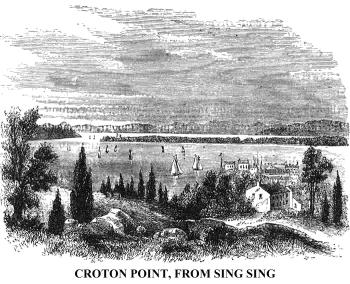 It was now the first day of March, and very warm; the surface of the river
was unruffled by a breeze. Knowing how boisterous and blustering this first
spring month generally is, I took advantage of the fine weather, and crossed
Tappan Bay to Rockland Lake village (formerly Slaughter's Landing), opposite
Sing Sing, the most extensive ice-station on the river. After considerable
delay, I procured a boat and oarsman--the former very leaky, and the latter
very accommodating. The bay is here between two and three miles wide. We passed
a few masses of floating ice and some sailing vessels, and at little past
noon landed at Rockland, where the Knickerbocker Ice Company had a wharf and
barges, and a large inclined-plane railway, down which ice, brought from the
adjacent lake, was sent to the vessels in the river.
It was now the first day of March, and very warm; the surface of the river
was unruffled by a breeze. Knowing how boisterous and blustering this first
spring month generally is, I took advantage of the fine weather, and crossed
Tappan Bay to Rockland Lake village (formerly Slaughter's Landing), opposite
Sing Sing, the most extensive ice-station on the river. After considerable
delay, I procured a boat and oarsman--the former very leaky, and the latter
very accommodating. The bay is here between two and three miles wide. We passed
a few masses of floating ice and some sailing vessels, and at little past
noon landed at Rockland, where the Knickerbocker Ice Company had a wharf and
barges, and a large inclined-plane railway, down which ice, brought from the
adjacent lake, was sent to the vessels in the river.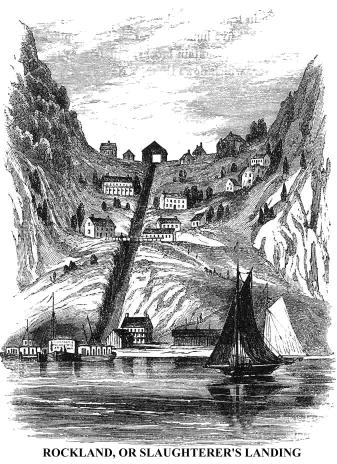
It was a weary way up the steep shore to the village and the
lake, on the borders of a high and well-cultivated valley, half a mile from
the river. This is the famous Rockland Lake, whose congealed waters have been
so long familiar to the thirsty dwellers in the metropolis. It is a lovely
sheet of water, one hundred and fifty feet above the river. On its south-eastern
borders, excepting where the village and ice-houses skirt it, are steep, rugged
shores. Westward, a fertile country stretches away many a mile to rough hills
and blue mountains. The lake is an irregular ellipse in form, half a mile
in length, and three-fourths of a mile at its greatest width, and covers about
five hundred acres. It is supplied by springs in its own bosom, and clear
mountain brooks, and forms the head waters of the Hackensack river, which
flows through New Jersey, and reaches the salt water in Newark Bay. Near its
outlet, upon a grassy peninsula, is the residence of Moses G. Leonard, Esq.,
seen in the picture; and in the distance, from our point of view, is seen
the peak of the great Torn Mountain, back of Haverstraw. Along the eastern
margin of the lake were extensive buildings for the storage of ice in winter,
at which time a thousand men were 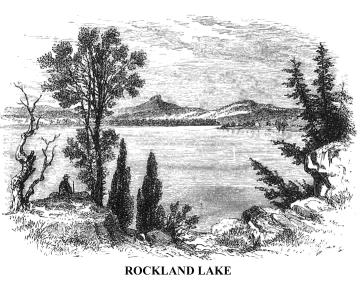 sometimes
employed. The crop averaged nearly two hundred thousand tons a-year; and during
the warm season, one hundred men were employed in conveying it to the river,
and fifteen barges were used in transporting it to New York, for distribution
there, and exportation.
sometimes
employed. The crop averaged nearly two hundred thousand tons a-year; and during
the warm season, one hundred men were employed in conveying it to the river,
and fifteen barges were used in transporting it to New York, for distribution
there, and exportation.
We crossed the bay to Croton Point, visited the villa and vineyards
of Doctor Underhill, and then rowed up Croton Bay to the mouth of the river,
passing, on our way, under the drawbridge of the Hudson River Railway. It
was late in the afternoon. There was a remarkable stillness and dreamy repose
in the atmosphere, and we glided almost noiselessly up the bay, in company
with two or three duck-hunters, in their little cockles. The tide was ebbing,
and as we approached the mouth of the Croton, 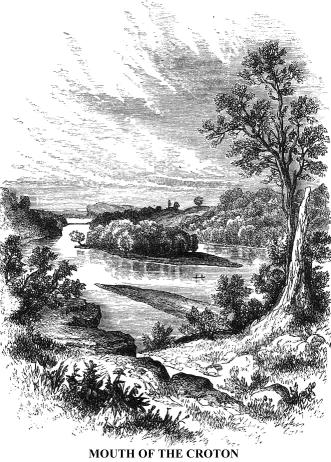 the
current became more and more rapid, until we found ourselves in a shallow
rift abreast the Van Cortlandt Manor House, unable to proceed. After vain
efforts of our united strength to stem the current, the boatman landed me
on the southern shore of the stream. After satisfying his extortionate demand
of about the price of three fares for his services, I dismissed him, with
a strong desire never again to fall into his hands; and then clambered up
the rough bank by the margin of a brook, and made my way to the "post
road," a most picturesque highway along the lofty banks of the Croton.
When near the "High Bridge," at the old head of boat navigation,
I obtained a most interesting view of the Mouth of the Croton, including Dover
Kill Island near, the railway-bridge in the distance, and the high hills on
the western shore of the Hudson in the extreme distance. The scenery thereabout
is both picturesque and beautiful, and such is its character to the very sources
of this famous stream eastward of the Pawling Mountains, whose clear waters
supply the city of New York with wholesome beverage.
the
current became more and more rapid, until we found ourselves in a shallow
rift abreast the Van Cortlandt Manor House, unable to proceed. After vain
efforts of our united strength to stem the current, the boatman landed me
on the southern shore of the stream. After satisfying his extortionate demand
of about the price of three fares for his services, I dismissed him, with
a strong desire never again to fall into his hands; and then clambered up
the rough bank by the margin of a brook, and made my way to the "post
road," a most picturesque highway along the lofty banks of the Croton.
When near the "High Bridge," at the old head of boat navigation,
I obtained a most interesting view of the Mouth of the Croton, including Dover
Kill Island near, the railway-bridge in the distance, and the high hills on
the western shore of the Hudson in the extreme distance. The scenery thereabout
is both picturesque and beautiful, and such is its character to the very sources
of this famous stream eastward of the Pawling Mountains, whose clear waters
supply the city of New York with wholesome beverage.
The ancient name of the Croton was Kitch-a-wan, signifying a large and swift current. The Dutch called it Croton in memory of an Indian Sachem of that name, whose habitation was on the northern border of the bay, near the neck, a little below the mouth of the river. Its sources are among the hills of Putnam and Duchess, and it has five considerable tributaries, all of mountain birth. When the authorities of the city of New York were seeking sources of ample supply of pure water, their attention was early called to this stream. Commissioners reported in favour of its use, though far away; and in May, 1837, the construction of an aqueduct from a point six miles from its mouth to the metropolis was begun. At the head of the aqueduct a dam was constructed, for the purpose of forming a fountain reservoir. At the beginning of 1841 a flood, produced by a protracted rain-storm and melting snows, swept away the dam, and carried with it, riverward, a quantity of earth and gravel, sufficient to half fill the beautiful Croton Bay. The dam was immediately rebuilt, at greater altitude, and a lake was produced, almost six miles in length, containing about 500,000,000 gallons. It is 166 feet above mean tide-water at New York, and pours into the aqueduct from 40,000,000 to 50,000,000 gallons every twenty-four hours. Not having time to visit the fountain reservoir. I have availed myself of the pencil services of a friend, in giving a sketch of the dam from a point just below it.
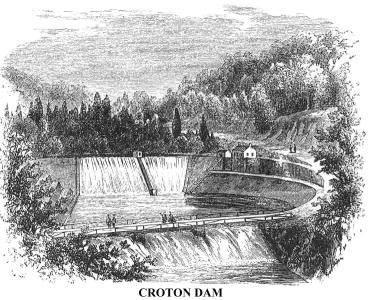 The
Croton aqueduct runs parallel with the Hudson, at the mean distance of half
a mile from it throughout its entire length. Its course is marked by culverts
and arches of solid masonry, and its line may be observed at a distance by
white stone towers, about fifteen feet in height, placed at intervals of a
mile. These are ventilators of the aqueduct; some of them are quite ornamental,
as in the case of the one at Sing Sing, others are simple round towers, and
every third one has a square base, with a door by which a person may enter
the aqueduct. At the top of each is an iron screen, to prevent substances
from being cast into the ventilators. Our little group shows the different
forms of these towers, which present a feature in the landscape on the eastern
shore of the river, to voyagers on the Hudson. This great work was completed,
and the water opened to the use of the inhabitants of New York, in the autumn
of 1842. Its cost was about $12,000,000. We shall meet with it frequently
in our future tour towards the city.
The
Croton aqueduct runs parallel with the Hudson, at the mean distance of half
a mile from it throughout its entire length. Its course is marked by culverts
and arches of solid masonry, and its line may be observed at a distance by
white stone towers, about fifteen feet in height, placed at intervals of a
mile. These are ventilators of the aqueduct; some of them are quite ornamental,
as in the case of the one at Sing Sing, others are simple round towers, and
every third one has a square base, with a door by which a person may enter
the aqueduct. At the top of each is an iron screen, to prevent substances
from being cast into the ventilators. Our little group shows the different
forms of these towers, which present a feature in the landscape on the eastern
shore of the river, to voyagers on the Hudson. This great work was completed,
and the water opened to the use of the inhabitants of New York, in the autumn
of 1842. Its cost was about $12,000,000. We shall meet with it frequently
in our future tour towards the city.
The "High Bridge" over the Croton, at the old head
of the navigation, was a wooden, rickety structure, 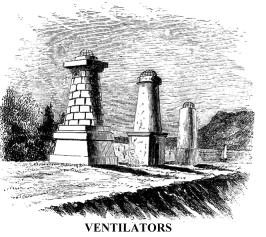 destined
soon to fall in disuse and absolute decay, because of a substantial new bridge,
then being constructed across the head of the bay, almost a mile below, by
which the route from Croton to Sing Sing would be much shortened. Here was
the "Croton Bridge" of revolutionary times, frequently mentioned
in connection with military movements between New York and the Highlands;
and here is now the scene of most important experiments in the production
of malleable iron from the ore, by a simple process, which, if successful,
would produce a marked change in the iron manufacture. It is a process of
deoxidizing iron ore in a heated hollow screw, out of which, when the process
is completed, it drops into the furnace, avoids all fluxes, and comes out
"blooms" of the finest iron. Mr. Rogers, the inventor, claimed that
by this process there would be a saving of from eight to twelve dollars a
ton in the production of iron--a matter of great importance to such isolated
districts as that of the Adirondack works at the sources of the Hudson already
mentioned. It was from Bayley's rolling mill, at the foot of the rapids in
the Croton, just above the old High Bridge, where these experiments were going
on, that I made the sketch of that dilapidated affair, just at sunset.
destined
soon to fall in disuse and absolute decay, because of a substantial new bridge,
then being constructed across the head of the bay, almost a mile below, by
which the route from Croton to Sing Sing would be much shortened. Here was
the "Croton Bridge" of revolutionary times, frequently mentioned
in connection with military movements between New York and the Highlands;
and here is now the scene of most important experiments in the production
of malleable iron from the ore, by a simple process, which, if successful,
would produce a marked change in the iron manufacture. It is a process of
deoxidizing iron ore in a heated hollow screw, out of which, when the process
is completed, it drops into the furnace, avoids all fluxes, and comes out
"blooms" of the finest iron. Mr. Rogers, the inventor, claimed that
by this process there would be a saving of from eight to twelve dollars a
ton in the production of iron--a matter of great importance to such isolated
districts as that of the Adirondack works at the sources of the Hudson already
mentioned. It was from Bayley's rolling mill, at the foot of the rapids in
the Croton, just above the old High Bridge, where these experiments were going
on, that I made the sketch of that dilapidated affair, just at sunset.
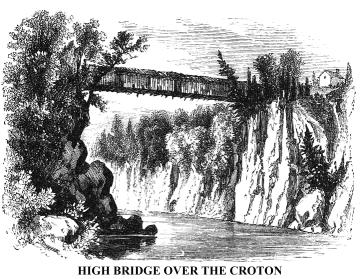 Crossing
the bridge, I strolled down the right bank of the Croton, along the high margin
of the stream, to the Van Cortlandt Manor House, passing the old Ferry House
on the way, where a party of New York levies, under Captain Daniel Williams,
were surprised by some British horsemen in the winter of 1782. At the entrance
gate to the mansion grounds, at twilight, I met Colonel Pierre Van Cortlandt,
the present proprietor, and accepted his cordial invitation to partake of
the hospitalities of his house for the night.
Crossing
the bridge, I strolled down the right bank of the Croton, along the high margin
of the stream, to the Van Cortlandt Manor House, passing the old Ferry House
on the way, where a party of New York levies, under Captain Daniel Williams,
were surprised by some British horsemen in the winter of 1782. At the entrance
gate to the mansion grounds, at twilight, I met Colonel Pierre Van Cortlandt,
the present proprietor, and accepted his cordial invitation to partake of
the hospitalities of his house for the night.
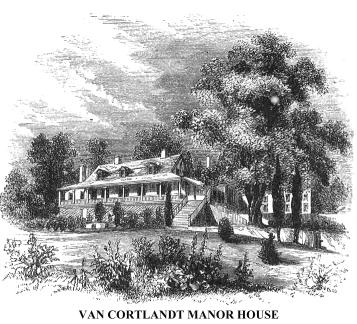 The
Van Cortlandt Manor House stands near the shore of Croton Bay. It was erected
at the beginning of the last century, by John Van Cortlandt, eldest son of
the first lord of the manor, and is now more than one hundred and fifty years
old. Orloff Stevenson Van Cortlandt, father of the first proprietor of this
estate, was a lineal descendant of the Dukes of Courland, in Russia. His ancestors
emigrated to Holland, when deprived of the Duchy of Courland. The family name
was Stevensen, or Stevenson, van (or from) Courland. They adopted the latter
as a surname, the true orthography of which, in Dutch, is Korte (short), and
landt (land), a term expressing the form of the ancient Duchy of Courland.
Orloff emigrated to America, and settled in New Amsterdam (New York), and
in 1697 his son Stephen purchased the large estate on the Hudson, afterwards
known as the Van Cortlandt Manor. By intermarriages, the Van Cortlandts are
connected with nearly all of the leading families of New York--the Schuylers,
Beckmans, Van Renselaers, De Peysters, De Lancys, Bayards, &c. The Manor
House was built of heavy stone; and the thick walls were pierced with loopholes
for musketry to be used in defence against the Indians. It has been somewhat
changed in aspect, by covering the round stone with stucco. Its front, graced
by a pleasant lawn, commands an extensive view of the bay, and of the Hudson
beyond. In that bay, under the shelter of Croton Point, Hendrick Hudson anchored
the Half-Moon, on the evening of the first of October, 1609; and such a resort
were these waters for canvas-back ducks, and other water-fowl, that, as early
as 1683, Governor Dongan came there to enjoy the sport of fowling. There,
too, great quantities of shad were caught. But its glory is departed. The
flood of 1841, that swept away the Croton Dam, almost filled the bay with
earth; it is accumulating there every hour; and, in the course of a few years,
the Van Cortlandt estate will have many acres of fine meadow land added to
it, where once large vessels might ride at anchor.
The
Van Cortlandt Manor House stands near the shore of Croton Bay. It was erected
at the beginning of the last century, by John Van Cortlandt, eldest son of
the first lord of the manor, and is now more than one hundred and fifty years
old. Orloff Stevenson Van Cortlandt, father of the first proprietor of this
estate, was a lineal descendant of the Dukes of Courland, in Russia. His ancestors
emigrated to Holland, when deprived of the Duchy of Courland. The family name
was Stevensen, or Stevenson, van (or from) Courland. They adopted the latter
as a surname, the true orthography of which, in Dutch, is Korte (short), and
landt (land), a term expressing the form of the ancient Duchy of Courland.
Orloff emigrated to America, and settled in New Amsterdam (New York), and
in 1697 his son Stephen purchased the large estate on the Hudson, afterwards
known as the Van Cortlandt Manor. By intermarriages, the Van Cortlandts are
connected with nearly all of the leading families of New York--the Schuylers,
Beckmans, Van Renselaers, De Peysters, De Lancys, Bayards, &c. The Manor
House was built of heavy stone; and the thick walls were pierced with loopholes
for musketry to be used in defence against the Indians. It has been somewhat
changed in aspect, by covering the round stone with stucco. Its front, graced
by a pleasant lawn, commands an extensive view of the bay, and of the Hudson
beyond. In that bay, under the shelter of Croton Point, Hendrick Hudson anchored
the Half-Moon, on the evening of the first of October, 1609; and such a resort
were these waters for canvas-back ducks, and other water-fowl, that, as early
as 1683, Governor Dongan came there to enjoy the sport of fowling. There,
too, great quantities of shad were caught. But its glory is departed. The
flood of 1841, that swept away the Croton Dam, almost filled the bay with
earth; it is accumulating there every hour; and, in the course of a few years,
the Van Cortlandt estate will have many acres of fine meadow land added to
it, where once large vessels might ride at anchor.
Copyright © 1998, -- 2004. Berry Enterprises. All rights reserved. All items on the site are copyrighted. While we welcome you to use the information provided on this web site by copying it, or downloading it; this information is copyrighted and not to be reproduced for distribution, sale, or profit.